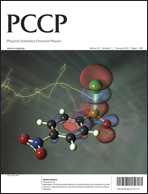亚纳米尺度上贾恩-泰勒通量金属团簇锥形交叉的支撑效应
IF 2.9
3区 化学
Q3 CHEMISTRY, PHYSICAL
引用次数: 0
摘要
通性概念被用来解释亚纳米尺寸的原子精密金属团簇的增强催化特性。孤立于气相中的 Cu3 是一种经典的通性金属团簇,其锥形交点会导致 Jahn-Teller (JT) 扭曲,从而形成具有近邻多峰的势能景观,最终形成通性行为。尽管锥形交点在表面支撑的原子金属团簇的(光)稳定性和(光)催化特性中起着重要作用,但它们在很大程度上尚未被探索。在这项工作中,我们以苯为模型支持分子,通过应用高水平多参考ab initio方法并辅以色散修正,分析了支持对Cu3锥形交点的影响。我们验证了当 Cu3 团簇以平行方向接近锥形交点时,锥形交点周围的区域和相关的 Jahn-Teller (JT) 畸变会受到支撑物非常轻微的扰动:在锥形交叉点处,两个电子态仍然是变性的,其结构的 C3 对称性与无支撑 Cu3 的 D3h 对称性一致。它延伸至一维接缝处,该接缝是 Cu3 苯复合物物理吸附最小值的特征。Cu3 簇的通性反映在作为活性 JT 模式函数的松弛 Cu-Cu 间距的大幅波动上,在与苯络合时也保持不变。与此形成鲜明对比的是,在 Cu3 平面与苯环平面垂直的能量取向中,锥形交叉点 (CI) 位于化学吸附最小值上方约 1.5 eV 处,通性在 CI 附近保持,而在化学吸附井处消失。垂直取向的第一激发态有一个深井,在能量上更接近 CI。基态和激发态之间的过渡偶极矩具有显著的大小,这表明激发态可以通过基态的直接光激发来观测。我们的研究结果表明,孤立的扬-泰勒金属簇的特性在物理吸附态时可以不受支持效应的影响,而在化学吸附态时则可以解除支持效应的影响。本文章由计算机程序翻译,如有差异,请以英文原文为准。
Support effects on conical intersections of Jahn-Teller fluxional metal clusters on the sub-nanoscale
The concept of fluxionality has been invoked to explain the enhanced catalytic properties of atomically precise metal clusters of subnanometer size. Cu3 isolated in the gas phase is a classical fluxional metal cluster where a conical intersection leads to a Jahn-Teller (JT) distortion resulting in a potential energy landscape with close-lying multiminima and, ultimately, fluxional behavior. In spite of the role of conical intersections in the (photo)stability and (photo)catalytic properties of surface-supported atomic metal clusters, they are largely unexplored. In this work, by applying a high-level multi-reference ab initio method aided with dispersion corrections, we analyze support effects on the conical intersection of Cu3 considering benzene as a model support molecule. We verify that the region around the conical intersection and the associated Jahn-Teller (JT) distortion is very slightly perturbed by the support when the Cu3 cluster approaches it in a parallel orientation: Two electronic states remain degenerate for a structure with a C3 symmetry consistent with the D3h symmetry of unsupported Cu3 at the conical intersection. It extends over a one-dimensional seam that characterizes a physisorption minimum of the Cu3-benzene complex. The fluxionality of the Cu3 cluster, reflected in large fluctuations of relaxed Cu-Cu distances as function of the active JT mode, is kept unperturbed upon complexation with benzene as well. In stark contrast, for the energetically favored perpendicular orientation of the Cu3 plane to the benzene ring plane, the conical intersection (CI) is located ~1.5 eV above the chemisorption minimum, with the fluxionality being kept at the CI's nearby and lost at the chemisorption well. The first excited state at the perpendicular orientation has a deep well, being energetically closer to the CI. The transition dipole moment between ground and excited states has a significant magnitude, suggesting that the excited state can be observed through direct photo-excitation from the ground state. Besides demonstrating that the identity of an isolated Jahn-Teller metal cluster can be preserved against support effects at a physisorption state and lifted out at a chemisorption state, our results indicate that a correlation exists between conical intersection topography and fluxionality in the metal cluster's Cu-Cu motifs.
求助全文
通过发布文献求助,成功后即可免费获取论文全文。
去求助
来源期刊

Physical Chemistry Chemical Physics
化学-物理:原子、分子和化学物理
CiteScore
5.50
自引率
9.10%
发文量
2675
审稿时长
2.0 months
期刊介绍:
Physical Chemistry Chemical Physics (PCCP) is an international journal co-owned by 19 physical chemistry and physics societies from around the world. This journal publishes original, cutting-edge research in physical chemistry, chemical physics and biophysical chemistry. To be suitable for publication in PCCP, articles must include significant innovation and/or insight into physical chemistry; this is the most important criterion that reviewers and Editors will judge against when evaluating submissions.
The journal has a broad scope and welcomes contributions spanning experiment, theory, computation and data science. Topical coverage includes spectroscopy, dynamics, kinetics, statistical mechanics, thermodynamics, electrochemistry, catalysis, surface science, quantum mechanics, quantum computing and machine learning. Interdisciplinary research areas such as polymers and soft matter, materials, nanoscience, energy, surfaces/interfaces, and biophysical chemistry are welcomed if they demonstrate significant innovation and/or insight into physical chemistry. Joined experimental/theoretical studies are particularly appreciated when complementary and based on up-to-date approaches.
 求助内容:
求助内容: 应助结果提醒方式:
应助结果提醒方式:


